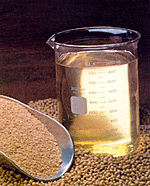What is Biodiesel?
Biodiesel is a cleaner burning diesel replacement fuel made from natural, renewable sources such as new and used vegetable oils and animal fats. Just like petroleum diesel, biodiesel operates in compression-ignition engines. Blends of 20% biodiesel with 80% petroleum diesel (B20) can be used in nearly all diesel equipment and are compatible with most storage and distribution equipment. These low-level blends generally do not require any engine modifications, however, users should consult their original equipment manufacturer and engine warranty statement.
Higher blends, even pure biodiesel (100% biodiesel, or B100), may be able to be used in some engines (built since 1994) with little or no modification. However, engine manufacturers are concerned about the impact of B100 on engine durability. Additionally, B100 is generally not suitable for use in low temperature conditions. Transportation and storage of B100, however, require special management.
Using biodiesel in a conventional diesel engine substantially reduces emissions of unburned hydrocarbons, carbon monoxide, sulfates, polycyclic aromatic hydrocarbons, nitrated polycyclic aromatic hydrocarbons, and particulate matter. These reductions increase as the amount of biodiesel blended into diesel fuel increases. The best emission reductions are seen with B100.
Nitrogen oxides (NOx) emissions from biodiesel increase or decrease depending on the engine family and testing procedures. NOx emissions (a contributing factor in the localized formation of smog and ozone) from pure biodiesel increase on average by 10 percent. However, biodiesel’s lack of sulfur allows the use of NOx control technologies that can not be used with conventional diesel. Additionally, some companies have successfully developed additives to reduce NOx emissions in biodiesel blends.
|
Regulated |
|
Total Unburned Hydrocarbons |
-67% |
-20% |
|
Carbon Monoxide |
-48% |
-12% |
|
Particulate Matter |
-47% |
-12% |
|
NOx |
(+)10% |
(+)2% to -2% |
|
Non-Regulated |
|
Sulfates |
-100% |
-20%* |
|
PAH (Polycyclic Aromatic Hydrocarbons)** |
-80% |
-13% |
|
nPAH (nitrated PAH's)** |
-90% |
-50%*** |
|
Ozone potential of speciated HC |
-50% |
-10% |
* Estimated from B100 result
** Average reduction across all compounds measured
*** 2-nitroflourine results were within test method variability
How is Biodiesel Made?
Biodiesel fuel can be made from new or used vegetable oils and animal fats, which are nontoxic, biodegradable, renewable resources. Fats and oils are chemically reacted with an alcohol (methanol is the usual choice) to produce chemical compounds known as fatty acid methyl esters. Biodiesel is the name given to these esters when they're intended for use as fuel.
Biodiesel can be produced by a variety of technologies. The oils and fats are filtered and preprocessed to remove water and contaminants. The pretreated oils and fats are then mixed with an alcohol and a catalyst. The oil molecules (triglycerides) are broken apart and reformed into methylesters and glycerol, which are then separated from each other and purified.
Approximately 55% of the biodiesel industry can use any fat or oil feedstock, including recycled cooking grease. The other half of the industry is limited to vegetable oils, the least expensive of which is soy oil. The soy industry has been the driving force behind biodiesel commercialization because of excess production capacity, product surpluses, and declining prices. Based on the combined resources of both industries, there is enough feedstock to supply 1.9 billion gallons of biodiesel (under policies designed to encourage biodiesel use). This represents roughly 5% of on-road diesel used in the United States.
Biodiesel Fuel Market
The use of biodiesel has grown dramatically during the last few years. The Energy Policy Act (EPAct) was amended by the Energy Conservation Reauthorization Act of 1998 to include biodiesel fuel use as a way for federal, state, and public utility fleets to meet requirements for using alternative fuels.
Pure biodiesel (B100) is considered an alternative fuel under EPAct. Lower-level biodiesel blends are not considered alternative fuels, but fleets can earn one EPAct credit for every 450 gallons of B100 purchased for use in blends of 20% or higher.
That amendment started the sharp increase in the number of biodiesel users, which now include the U.S. Postal Service and the U.S. Departments of Defense, Energy, and Agriculture. Countless school districts, transit authorities, national parks, public utility companies, and garbage and recycling companies also use the fuel.
Currently, there is a biodiesel tax incentive that is a federal tax credit. The credit equates to a one penny per percent of biodiesel in a fuel blend made from agricultural products like vegetable oils, and one-half penny per percent for recycled oils. This incentive is taken by petroleum distributors and passed on to consumers. The United States Department of Agriculture developed a study that estimated this incentive will increase the demand for biodiesel to at least 124 million gallons per year. And depending on other factors, including crude oil prices, the industry projects that demand could be much higher.
Biodiesel Use in Florida
Florida’s Department of Greenways & Trails is pumping biodiesel into its fleet of field trucks. The field vehicles tow tractors and heavy-duty maintenance equipment over the rugged terrain of the 110-mile Cross Florida Greenway and along paved highways. The average vehicle travels more than 300 miles a week.
In the state of Florida, there are a wide range of biodiesel users including Florida Power and Light, the city of Jacksonville, and the Everglades National Park.
As of March, 2006, the Broward County Fort Lauderdale-Hollywood International Airport is using five new biodiesel hybrid electric buses. These biodiesel hybrid electric buses will be used primarily on the Airport’s remote parking route and intra-terminal loop. Currently, the Broward County Fort Lauderdale-Hollywood International Airport is using a B20 biodiesel blend (20% biodiesel, 80% diesel).
Biodiesel Benefits
Environmental Benefits
Biodiesel contains no sulfur or aromatics, and use of biodiesel in a conventional diesel engine results in substantial reduction of unburned hydrocarbons, carbon monoxide and particulate matter (all air pollutants under the Clean Air Act). A U.S. Department of Energy study showed that the production and use of biodiesel, compared to petroleum diesel, resulted in a 78.5% reduction in carbon dioxide emissions (a greenhouse gas). Moreover, biodiesel has a positive energy balance. For every unit of energy needed to produce a gallon of biodiesel, 3.24 units of energy are gained.
Economic Benefits
Increased utilization of renewable biofuels results in significant microeconomic benefits to both the urban and rural sectors, and the balance of trade. A study completed in 2001 by the U.S. Department of Agriculture found that an average annual increase of the equivalent of 200 million gallons of soy-based biodiesel demand would boost total crop cash receipts by $5.2 billion cumulatively by 2010, resulting in an average net farm income increase of $300 million per year. The price for a bushel of soybeans would increase by an average of 17 cents annually during the ten-year period.
In addition to being a domestically produced, renewable alternative fuel for diesel engines, biodiesel has positive performance attributes such as high fuel lubricity and high oxygen content, which may make it a preferred blending stock with future ultra-clean diesel.
Since biodiesel can be used in conventional diesel engines, the renewable fuel can directly replace petroleum products; reducing the country's dependence on imported oil.
Quality Benefits
Biodiesel is registered as a fuel and fuel additive with the EPA and meets clean diesel standards established by the California Air Resources Board (CARB). B100 (100 percent biodiesel) has been designated as an alternative fuel by the U.S. Department of Energy and the U.S. Department of Transportation.
Biodiesel can be used in conventional diesel engines, and special vehicles or engines to run biodiesel do not need to be purchased.
The National Biodiesel Board, the trade association for the biodiesel industry, has formed the National Biodiesel Accreditation Commission (NBAC) to audit fuel producers and marketers in order to enforce fuel quality standards in the U.S. NBAC issues a ‘Certified Biodiesel Marketer’ seal of approval for biodiesel marketers that have met all requirements of fuel accreditation audits. This seal of approval will provide added assurance to customers, as well as engine manufacturers, that the biodiesel marketed by these companies meets the American Society for Testing & Materials (ASTM) standards for biodiesel and that the fuel supplier will stand behind its products.
Biodiesel offers safety benefits over petroleum diesel because it is much less combustible, with a flash point greater than 150°C, compared to 77°C for petroleum diesel. It is safe to handle, store, and transport.
Biodiesel Related Links
